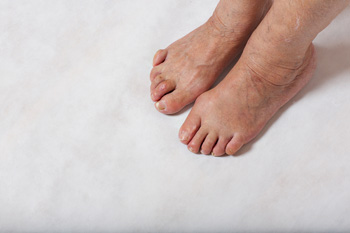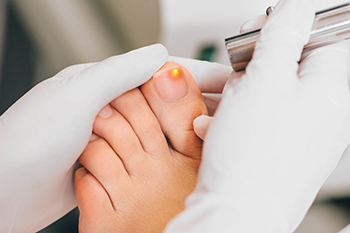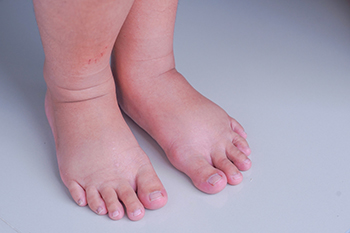Glen Allen Office
(804) 747-3380

Athlete's foot is a particular foot condition that is essentially a fungal infection. Caused by a fungus, athlete's foot is characterized by scaly skin texture and redness. Many patients often wonder who can develop athlete's foot. The answer is that athlete’s foot can develop in someone regardless of their age, sex, or race. Importantly, there are certain things that can make an individual more susceptible to developing athlete’s foot. For example, if you are someone that spends a significant amount of time not wearing shoes in warm, moist, public areas, then you might be at a higher risk of developing athlete’s foot. To learn more about this condition and receive any treatment that might be necessary, it is suggested that you contact a podiatrist today.
Athlete’s foot is an inconvenient condition that can be easily reduced with the proper treatment. If you have any concerns about your feet and ankles, contact one of our podiatrists from The Podiatry Center. Our doctors will treat your foot and ankle needs.
Athlete’s Foot: The Sole Story
Athlete's foot, also known as tinea pedis, can be an extremely contagious foot infection. It is commonly contracted in public changing areas and bathrooms, dormitory style living quarters, around locker rooms and public swimming pools, or anywhere your feet often come into contact with other people.
Solutions to Combat Athlete’s Foot
Athlete’s foot can cause many irritating symptoms such as dry and flaking skin, itching, and redness. Some more severe symptoms can include bleeding and cracked skin, intense itching and burning, and even pain when walking. In the worst cases, Athlete’s foot can cause blistering as well. Speak to your podiatrist for a better understanding of the different causes of Athlete’s foot, as well as help in determining which treatment options are best for you.
If you have any questions please feel free to contact one of our offices located in Richmond and Glen Allen, VA . We offer the newest diagnostic and treatment technologies for all your foot and ankle needs.

A hammertoe is a toe deformity where the toe is bent downward at the joint, resembling a hammer. This can happen in children because of a congenital disability, wearing shoes that do not fit well, or pressure from a bunion. Buying comfortable shoes with the right size and a wide enough toe box for the toes to spread out is critical. Using a corn pad to protect the hammertoe can help relieve pressure and discomfort from friction within shoes. A child with a hammertoe can also benefit from stretching their toe muscles throughout the day. It is important to treat this condition in children to prevent future foot problems. If your child has a hammertoe, it is strongly suggested that you visit a podiatrist who can provide a plan of treatment to ease pain, correct the deformity, and protect their feet from developing further issues.
Hammertoe
Hammertoes can be a painful condition to live with. For more information, contact one of our podiatrists from The Podiatry Center. Our doctors will answer any of your foot- and ankle-related questions.
Hammertoe is a foot deformity that affects the joints of the second, third, fourth, or fifth toes of your feet. It is a painful foot condition in which these toes curl and arch up, which can often lead to pain when wearing footwear.
Symptoms
Causes
Genetics – People who are genetically predisposed to hammertoe are often more susceptible
Arthritis – Because arthritis affects the joints in your toes, further deformities stemming from arthritis can occur
Trauma – Direct trauma to the toes could potentially lead to hammertoe
Ill-fitting shoes – Undue pressure on the front of the toes from ill-fitting shoes can potentially lead to the development of hammertoe
Treatment
Orthotics – Custom made inserts can be used to help relieve pressure placed on the toes and therefore relieve some of the pain associated with it
Medications – Oral medications such as anti-inflammatories or NSAIDs could be used to treat the pain and inflammation hammertoes causes. Injections of corticosteroids are also sometimes used
Surgery – In more severe cases where the hammertoes have become more rigid, foot surgery is a potential option
If you have any questions please contact one of our offices located in Richmond and Glen Allen, VA . We offer the newest diagnostic and treatment technologies for all your foot and ankle needs.

Toenail fungus is a common foot condition, and there is a remedy available that may benefit some patients. It is referred to as laser treatment, and it may be a promising option for this stubborn foot condition. It is done by using concentrated light that is aimed at the toenails which may help to eliminate the fungus, and prevent it from growing. Research has shown that the majority of patients will have little or no discomfort while getting this procedure done, and it is easily administered. There is generally no recovery time needed, and as the toenail grows, results may begin to be seen in approximately two months. There is a reduced risk of complications, which can make this treatment potentially safe for pregnant women and children to undergo. If you are interested in this type of treatment, it is suggested that you consult with a podiatrist who can help you to make a correct decision.
Laser treatment can be an effective way to get rid of toenail fungus. If you have any questions about laser treatment, consult with one of our podiatrists from The Podiatry Center. Our doctors will assess your condition and provide you with quality treatment for fungal nails.
What Are Toenail Fungal Infections?
Onychomycosis, or fungal infection of the nail, is a relatively common and non-serious condition. Around 10 percent of U.S. citizens are afflicted with fungal nails. Common forms of fungus that infect the nail include dermatophytes, yeasts, and molds.
Symptoms of Toenail Fungal Infections Include:
Diagnosis for Fungal Nails
Fungal infections are diagnosed by fungal culture and microscopy. This will rule out any other conditions such as nail trauma, psoriasis, lichen planus, and onychogryphosis.
What Is Laser Treatment?
Laser treatment is a non-invasive, safe, quick, and painless procedure that uses the heat from a laser to kill fungus in the nail. Each infected nail is targeted with a laser for several minutes. The treatment is usually utilized several different times over a select period. During this time, a podiatrist will keep an eye on the infection.
If you have any questions, please feel free to contact one of our offices located in Richmond and Glen Allen, VA . We offer the newest diagnostic and treatment technologies for all your foot care needs.

Ankle surgery may be performed if the ankle has been severely injured, or if there is existing arthritis or torn ligaments. Ankle fusion is a type of surgery that has increased dramatically in recent years. This may follow any conservative treatments that may have failed, leaving surgery as the only option. A displaced ankle fracture may require a closed reduction procedure to be performed. This is done by aligning the bones from the outside of the ankle, which may produce severe pain during the procedure. If the bones cannot be manipulated from the outside, an open reduction can be done that uses screws or plates. This may be a common type of surgery among patients who have ankle instability. If you have ankle pain, it is suggested that you confer with a podiatrist who can determine if having ankle surgery is right for you.
Foot surgery is sometimes necessary to treat a foot ailment. To learn more, contact one of our podiatrists of The Podiatry Center. Our doctors will assist you with all of your foot and ankle needs.
When Is Surgery Necessary?
Foot and ankle surgery is generally reserved for cases in which less invasive, conservative procedures have failed to alleviate the problem. Some of the cases in which surgery may be necessary include:
What Types of Surgery Are There?
The type of surgery you receive will depend on the nature of the problem you have. Some of the possible surgeries include:
Benefits of Surgery
Although surgery is usually a last resort, it can provide more complete pain relief compared to non-surgical methods and may allow you to finally resume full activity.
Surgical techniques have also become increasingly sophisticated. Techniques like endoscopic surgery allow for smaller incisions and faster recovery times.
If you have any questions please feel free to contact one of our offices located in Richmond and Glen Allen, VA . We offer the newest diagnostic and treatment technologies for all your foot and ankle needs.

To say the feet are critical to functioning is an understatement. They absorb the full impact of the body’s weight, while keeping the body balanced and upright. A host of problems can affect the feet, which can impact comfort and reduce mobility. These can include cracked skin, ingrown toenails, and injured bones. Following a simple foot care routine can help keep the skin, bones, and muscles of the feet functioning properly. Wearing well-fitted shoes that are supportive and comfortable are key factors in maintaining good foot health. If you shop for new shoes, it is important to do so later in the day when the feet are at their largest. The feet are then measured with the socks that will be worn with the intended shoes. It is beneficial for the feet to be exercised to stay strong, and simply walking can fulfill this need. Washing, drying, and moisturizing the feet daily, in addition to wearing socks that can add shock absorption, may help to protect the feet. If foot conditions develop, or if you would like more information about how you can take better care of your feet, it is suggested that you consult with a podiatrist.
Everyday foot care is very important to prevent infection and other foot ailments. If you need your feet checked, contact one of our podiatrists from The Podiatry Center. Our doctors can provide the care you need to keep you pain-free and on your feet.
Everyday Foot Care
Often, people take care of their bodies, face and hair more so than they do for their feet. But the feet are a very important aspect of our bodies, and one that we should pay more attention to. Without our feet, we would not be able to perform most daily tasks.
It is best to check your feet regularly to make sure there are no new bruises or cuts that you may not have noticed before. For dry feet, moisturizer can easily be a remedy and can be applied as often as necessary to the affected areas. Wearing shoes that fit well can also help you maintain good foot health, as well as making it easier to walk and do daily activities without the stress or pain of ill-fitting shoes, high heels, or even flip flops. Wearing clean socks with closed shoes is important to ensure that sweat and bacteria do not accumulate within the shoe. Clean socks help to prevent Athlete’s foot, fungi problems, bad odors, and can absorb sweat.
If you have any questions please feel free to contact one of our offices located in Richmond and Glen Allen, VA . We offer the newest diagnostic and treatment technologies for all your foot and ankle needs.

People who have pain in the arch of their foot may benefit by performing specific types of stretching exercises that target that part of the foot. The plantar fascia is located on the sole of the foot and connects the heel to the toes. It can become damaged from standing or running for long periods of time, or from wearing shoes that do not fit correctly. Performing a plantar fascia stretch is done by crossing one foot over the opposite knee while sitting in a chair. It begins by grabbing the heel and pulling it with one hand and using the other hand to bring the toes in the opposite direction. This stretch is felt along the bottom of the foot and can be repeated up to four times after holding it for several seconds. The Achilles tendon connects the heels to the calf muscles, and a calf stretch can help to strengthen the heel. This can be accomplished by standing on a step and lowering one heel at a time until a gentle stretch is felt. If you would like more information about what types of foot stretches to perform for an inflamed plantar fascia, it is suggested that you confer with a podiatrist.
Stretching the feet is a great way to prevent injuries. If you have any concerns with your feet consult with one of our podiatrists from The Podiatry Center. Our doctors will assess your condition and provide you with quality foot and ankle treatment.
Stretching the Feet
Being the backbone of the body, the feet carry your entire weight and can easily become overexerted, causing cramps and pain. As with any body part, stretching your feet can serve many benefits. From increasing flexibility to even providing some pain relief, be sure to give your feet a stretch from time to time. This is especially important for athletes or anyone performing aerobic exercises, but anyone experiencing foot pain or is on their feet constantly should also engage in this practice.
Great ways to stretch your feet:
Individuals who tend to their feet by regular stretching every day should be able to minimize foot pain and prevent new problems from arising.
If you have any questions, please feel free to contact one of our offices located in Richmond and Glen Allen, VA . We offer the newest diagnostic and treatment technologies for all your foot care needs.

The condition that is known as plantar fasciitis affects the heel and arch of the foot. There is a band of tissue called the plantar fascia, which connects the heels to the toes. It is found on the sole of the foot, and it can become inflamed or torn for various reasons. These reasons can include wearing shoes that do not fit correctly, or standing on hard surfaces for most of the day. People who are overweight may be prone to getting plantar fasciitis, which may be a result of having the added weight the feet must bear. The pain may be worse in the morning when awakening, and may start to feel better when the foot is moved. Mild relief may be found when custom-made insoles are worn in the shoe, and the foot is frequently elevated. There are specific stretches that can be done, which may help to ease the discomfort from plantar fasciitis. The heel can be stretched by standing on a step while lowering one heel at a time until a gentle pull is felt. If you are afflicted with this condition, it is suggested that you confer with a podiatrist who can provide you with permanent relief options.
Plantar fasciitis is a common foot condition that is often caused by a strain injury. If you are experiencing heel pain or symptoms of plantar fasciitis, contact one of our podiatrists from The Podiatry Center. Our doctors can provide the care you need to keep you pain-free and on your feet.
What Is Plantar Fasciitis?
Plantar fasciitis is one of the most common causes of heel pain. The plantar fascia is a ligament that connects your heel to the front of your foot. When this ligament becomes inflamed, plantar fasciitis is the result. If you have plantar fasciitis you will have a stabbing pain that usually occurs with your first steps in the morning. As the day progresses and you walk around more, this pain will start to disappear, but it will return after long periods of standing or sitting.
What Causes Plantar Fasciitis?
There are some risk factors that may make you more likely to develop plantar fasciitis compared to others. The condition most commonly affects adults between the ages of 40 and 60. It also tends to affect people who are obese because the extra pounds result in extra stress being placed on the plantar fascia.
Prevention
There are a variety of treatment options available for plantar fasciitis along with the pain that accompanies it. Additionally, physical therapy is a very important component in the treatment process. It is important that you meet with your podiatrist to determine which treatment option is best for you.
If you have any questions, please feel free to contact one of our offices located in Richmond and Glen Allen, VA . We offer the newest diagnostic and treatment technologies for all your foot care needs.

Having swollen feet and ankles is a normal condition many pregnant women experience. It is generally temporary, despite the discomfort it can bring. One of the changes the body undergoes consists of retaining fluids, which often collect in the lower extremities. The developing fetus causes the blood to become thicker, providing the necessary nutrients during this time. It is helpful to avoid standing for prolonged periods, and walking can help to improve circulation. If the swelling is severe, compression stockings may be worn that can help to move the fluids away from the ankles. Additionally, the swelling may be reduced when sodium intake is limited, and cool environments are preferred, keeping the body temperature comfortable. If you would like more information about how pregnancy affects the feet, it is suggested that you consult with a podiatrist who can address any concerns you may have.
Pregnant women with swollen feet can be treated with a variety of different methods that are readily available. For more information about other cures for swollen feet during pregnancy, consult with one of our podiatrists from The Podiatry Center. Our doctors will attend to all of your foot and ankle needs.
What Foot Problems Can Arise During Pregnancy?
One problem that can occur is overpronation, which occurs when the arch of the foot flattens and tends to roll inward. This can cause pain and discomfort in your heels while you’re walking or even just standing up, trying to support your baby.
Another problem is edema, or swelling in the extremities. This often affects the feet during pregnancy but tends to occur in the later stages.
How Can I Keep My Feet Healthy During Pregnancy?
If you have any questions please feel free to contact one of our offices located in Richmond and Glen Allen, VA . We offer the newest diagnostic and treatment technologies for all your foot and ankle needs.